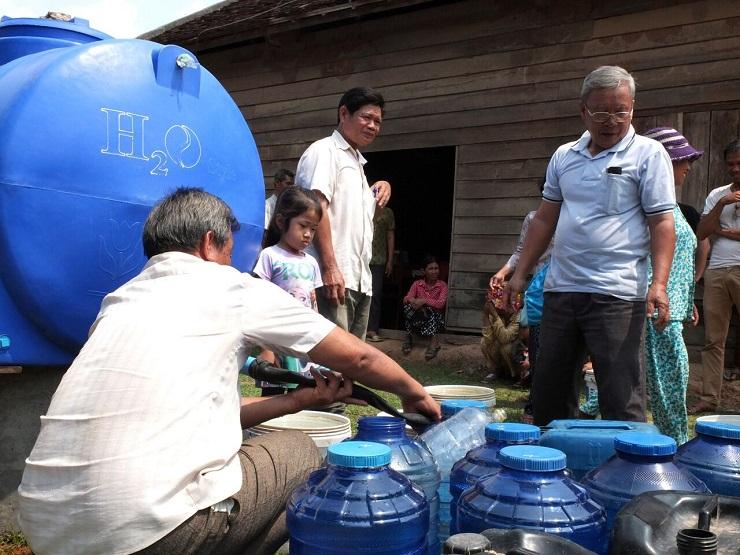ENGLISH
Cambodia gripped by severe water crisis
"In the scorching heat, wells have dried up and drinking water is scarce, as Cambodia deals with the worst drought in its history."

The annual rains in Cambodia typically start to fall in May. But this year, even as the first rains begin to fall, the country is being gripped by a water crisis.
In the scorching heat, wells have dried up and drinking water is scarce, as Cambodia deals with the worst drought in its history.
Ilana Tulloch has this report from the province of Cikrang.
Cikrang is the last district before you leave Siem Reap province, on the way to Phnom Penh.
As we drive past a wedding celebration, along the red-dirt roads winding deeper into the countryside, we can see the ground is wet from a recent downpour – the first for Siem Reap this year.
But the rain doesn’t mean the effects of the drought are over.
“I’ve been the village leader for 3 government terms and this is the worst drought I have ever seen since I have been taking care of these villages.”
That’s Leou Chanda, the head of Cikrang. The area is home to an estimated 75 hundred people, with at least 450 families who have what is called an “ID Poor Equity Card”.
The card is part of a government scheme that entitles holders to free healthcare, food aid and scholarship programs for students.
Chanda has been working on solutions to the water crisis, but says that at 68 years old, she’s finding it difficult to do on her own.
“I raised money to control the water from the river and built a small dam to keep the water flowing away into the river. This gave the villagers some water,” Chanda told me.
“I knew it wasn’t clean, it was very dirty, but it gave them something. But that dried up so then I asked the district leaders for help and they sent 38 trucks of water. The water was also unclean but was better than nothing at all.”
![]()
In Cambodia, families on the ID Poor Card program suffer from the worst levels of poverty, and are feeling the brunt of the immediate water crisis.
Just last month, there were more than 500 cases of severe dehydration recorded by the local clinic in Cikrang.
Sngoon Peak, a rice farmer from Cikrang tells me that both her children have been sick with diarrhea and dehydration.
The small ponds used by her family, she says, are now just cracked earth.
It’s the reason why the Life Project, an NGO focused on education and development programs in Cikrang, has stepped in.
“The river was completely dry except for a few ponds along the riverbed. You could literally drive a car down the river,” says Vin Kebblewhite, the Australian director and founder of the Life Project.
“If the few showers of rain they’ve had in the last few days stop again it would probably only take 2-3 days for the same situation to come back.”
Kebblewhite says the ponds that have been dug in people’s yards have all dried up – except for a few stagnant, polluted pools of water, which is incredibly dangerous to consume.
“There are only 4 homes in Cikrang with metered water, with 70% of homes having no direct access to water. Those who do have metered water are having it pumped from a privately owned well 12 kilometres away,” Kebblewhite tells me.
“Most families are dependent on surface water from the river and man-made ponds. But those options have all dried up.”
“We’ve worked out a way, for a total of $50 a week, that we can get 20 Litres per day to 600 families to ease the crisis,” Kebblewhite said.
In collaboration with private donors, Mrs Leou Chanda and other community officials, the Life Project has purchased water from the same privately owned well.
The purchased water will amount to 12,000 liters per day, 6 days a week.
Each family is eligible to 20 liters per day and must come to a collection point run by a local official, acknowledging receipt of the water with a thumbprint.
Peak, the rice farmer I spoke to as she lined up, is very excited about the free water.
Because water is so precious right now, she vowed to only use it for drinking.
The donations are easing some of the need, but locals here are still worried about what they will do if the drought continues to worsen, says Peak.
“I worry that there isn’t enough water for my children. I tell the water trucks, ‘Why don’t you sell at my village?’ And the men say ‘You don’t have any money to buy! How can we sell at your village?”
But the Life Project is thinking long-term, says Kebblewhite.
“We would like to work with the local commune officials in building up water security for the village and in having extra backup water but also see obviously a larger number of families have water filters that can cope with quite dirty water.”
In the meantime locals are in good humor, despite the challenges.
Peak’s backup plan if the clean water from The Life Project runs out causes the room to erupt in laughter.
She says she’ll just sneak water from the local Buddhist pagoda.
If the monk gets angry and lectures her that the pagoda might run out water, she’ll just continue as she has been – blocking her ears so she won’t be able to hear him talking, while she takes water for her children.
- Cambodia drought
- Life Project
- Ilana Tulloch
Komentar (0)
KBR percaya pembaca situs ini adalah orang-orang yang cerdas dan terpelajar. Karena itu mari kita gunakan kata-kata yang santun di dalam kolom komentar ini. Kalimat yang sopan, menjauhi prasangka SARA (suku, agama, ras dan antargolongan), pasti akan lebih didengar. Yuk, kita praktikkan!